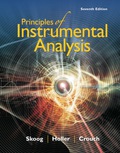
Principles of Instrumental Analysis
7th Edition
ISBN: 9781337468039
Author: Skoog
Publisher: Cengage
expand_more
expand_more
format_list_bulleted
Question
Chapter 4, Problem 4.3QAP
Interpretation Introduction
Interpretation:
To decide out of binary and BCD which system of encoding decimal numbers is more efficient based on number of bits taken for encoding and the reason should be determined due to which less efficient coding scheme is very useful.
Concept introduction
BCD:
A decimal number can be converted into its BCD equivalent by replacing each digit of given decimal number into its corresponding four-bit binary equivalent.
Binary:
A decimal number can be converted into its binary equivalent by continually dividing it by 2 and keeping track of the remainder.
Expert Solution & Answer
Want to see the full answer?
Check out a sample textbook solution
Students have asked these similar questions
Draw the
Show the major and minor product(s) for the following reaction
mechanisms for both reactions and show all resonance structures for any
Explain why the major product is favoured?
intermediates
H-Br
Choose the right answer
8.
What is the major product of the following reaction?
KMnO4
b
a
TOH
OH
OH
C
d
OH
"OH
HO
OH
OH
Knowledge Booster
Similar questions
- Choose the right answerarrow_forward3. Draw ALL THE POSSBILE PRODUCTS AND THE MECHANISMS WITH ALL RESONANCE STRUCTURES. Explain using the resonance structures why the major product(s) are formed over the minor product(s). H₂SO4, HONO CHarrow_forward7. Provide the product(s), starting material(s) and/or condition(s) required for the No mechanisms required. below reaction HO + H-I CI FO Br2, FeBr3 O I-Oarrow_forward
- 6. Design the most efficient synthesis of the following product starting from phenot Provide the reaction conditions for each step (more than one step is required) and explain the selectivity of each reaction. NO MECHANISMS ARE REQUIRED. OH step(s) CIarrow_forwardWhat is the skeletal structure of the product of the following organic reaction?arrow_forwardIf a reaction occurs, what would be the major products? Please include a detailed explanation as well as a drawing showing how the reaction occurs and what the final product is.arrow_forward
- What is the major organic product of the following nucleophilic acyl substitution reaction of an acid chloride below?arrow_forwardWould the following organic synthesis occur in one step? Add any missing products, required catalysts, inorganic reagents, and other important conditions. Please include a detailed explanation and drawings showing how the reaction may occur in one step.arrow_forwardIf a reaction occurs, what would be the major products? Please include a detailed explanation as well as a drawing showing how the reaction occurs and what the final product is.arrow_forward
- Please help me answer the following questions using the data I included. 1&2arrow_forwardAssign all the Protons in HNMRarrow_forwardProvide the missing information HO NO2 Br2 FeBr3 to CI HO H₂N NO2 AICI3 Zn(Hg), HCI 1. NBS 2. t-BuONa 1. Br₂, FeBr3 2. CH3CI, AC13 3. Na2Cr2O7 Br NH2 SO3H HO H₂N Brarrow_forward
arrow_back_ios
SEE MORE QUESTIONS
arrow_forward_ios
Recommended textbooks for you
 Principles of Instrumental AnalysisChemistryISBN:9781305577213Author:Douglas A. Skoog, F. James Holler, Stanley R. CrouchPublisher:Cengage Learning
Principles of Instrumental AnalysisChemistryISBN:9781305577213Author:Douglas A. Skoog, F. James Holler, Stanley R. CrouchPublisher:Cengage Learning

Principles of Instrumental Analysis
Chemistry
ISBN:9781305577213
Author:Douglas A. Skoog, F. James Holler, Stanley R. Crouch
Publisher:Cengage Learning
